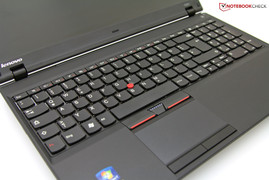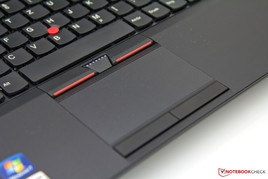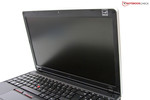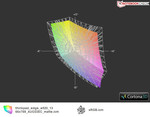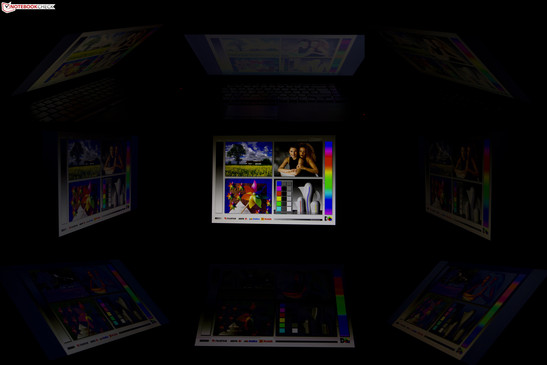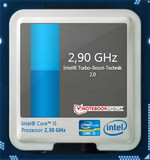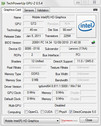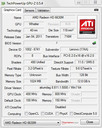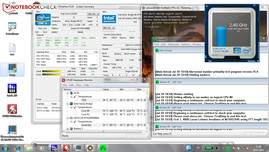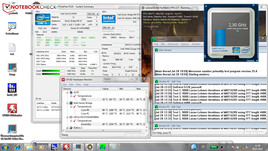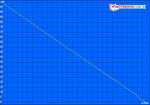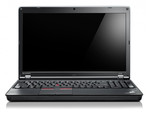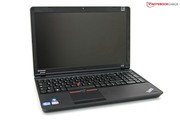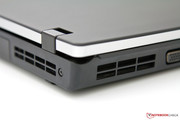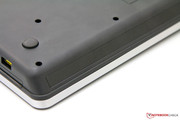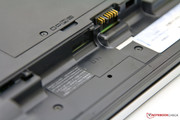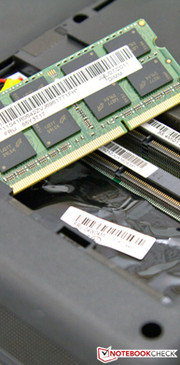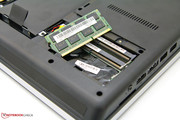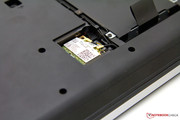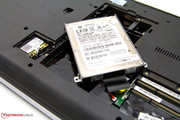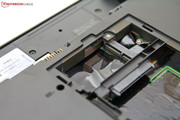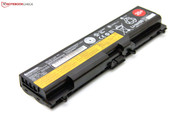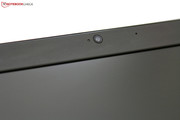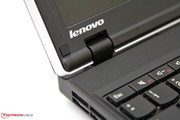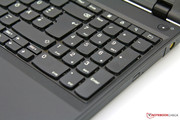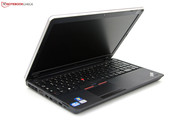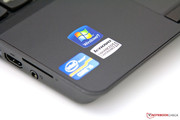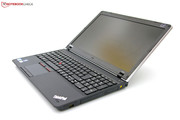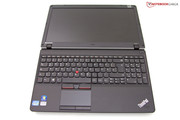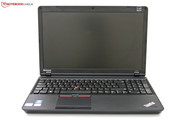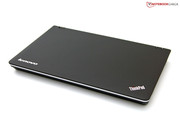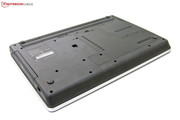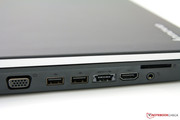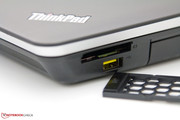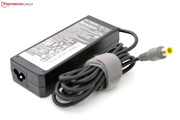Review Lenovo Thinkpad Edge E520 Notebook

Lenovo's ThinkPad Edge series is aimed at buyers who find standard ThinkPads too expensive or too dull. The top tier of the Edge series comprises of the Lenovo ThinkPad Edge E520, the smaller E420 and the previously tested E420s (the two should not be confused with each other). The E520 is quite different from the usual B2B notebooks. The laptop has a matt 15.6 inch display and a subtle design. The front of the laptop is angled like a wedge and the laptop manages to leave a good impression even without the use of shiny lacquer. The notebook runs on the latest hardware, and the user can customize the laptop extensively before purchasing. We picked the mainstream configuration which offers an Intel Core i5-2410M, an AMD Radeon HD 6630M graphics chip and 4 GB of RAM.
Lenovo will soon release the ThinkPad Edge E425 and E525, both of which use the new AMD Llano-APUs instead of the popular Intel mobile CPUs. In the USA, these notebooks will be available starting at 549 US dollars. Currently, our test model is priced (the mainstream configuration without UMTS module) costs around 650 Euros. In the following review, we will push the laptop through a variety of benchmarks and tests. The ThinkPad Edge E420s may not have made the cut, but the question remains: has Lenovo found the perfect middle-ground between cheap mainstream notebooks and expensive high-end business devices in the ThinkPad Edge E520?
Case
"New Design. New Form. And Better Than Ever." - Lenovo gives the E520 wholehearted support, as is apparent from the above motto. It seems that they might be promising too much as the test model before us seems rather chunky with a weight of 2.46 kilograms and a (maximum) height of 33 millimeters. The matt black surface has a nice "Soft touch" surface coating and the front of the case flattens abruptly like a wedge. The colors available for this model may not be extravagant, but the robust case makes up for it. The case is hard to scratch, but fingerprints accumulate quickly. The workmanship of the notebook is disappointing: the synthetic material used for the case looks cheap in parts, the battery sits loosely, and the display cover is weak.
The sturdiness of the base left us divided. On the one hand, the hand-rest regions proved to be quite resistant, whereas the keyboard gives way near the middle and above the DVD drive. Lenovo has picked high-quality metal hinges for the E520. The black hinges manage to hold the display with minimal movement most of the time. However, when the display is pushed backwards, the hinges have a hard time holding it securely. This is especially evident when the display is opened at angles between 160 degrees and 180 degrees.
A T-shaped flap on the bottom of the laptop hides the RAM and the hard disk. Once removed, the RAM and the hard disk can be easily swapped out or upgraded. Unfortunately, the case fans can not be reached, which means that there is no way to clean out the dust which gather over time. The ThinkPad Edge E520 is set apart from typical business notebooks due to the missing docking interface at the bottom of the laptop.
Connectivity
The laptop also stands apart from other consumer devices thanks to its extensive connectivity: a total of 5 USB 2.0 ports (one of which is a fast eSATA combination interface), a VGA and HDMI ouput, and an ExpressCard slot for 34 mm cards. All-in-all, the multitude of interfaces make up for the missing USB 3.0 ports. As previously mentioned, the laptop also lacks a docking port interface.
All the ports of the notebook (except for the RJ-45 LAN port) can be found on the right and left sides of the case. The positioning is not exceptional; however, the use of the USB port and ExpressCard slot on the right side could restrict the movements of an external mouse.
Communication
The test model is strapped to its teeth with the latest communication modules. The laptop offers 1 GB/s wire transfer rate, a WLAN 802.11b/g/n (Intel WiFi Link 1000 BGN) as well as Bluetooth 3.0 +HS (all of which are included from the factory). Our test model offered no 3G-UMTS module. That is available for a premium and the slot for that module is already placed in the device. However, the necessary antennas for installing the module are not already in place, which prevents users from adding the card after purchasing the notebook.
Security
A pure-bred business notebook needs security features. The E520 is the "golden middle-ground", which means that it does not offer most of the features elite business notebook users are accustomed to. The test model has a Kensington Lock slot, but other features such as a TPM chip, a SmartCard-reader and a Fingerprint sensor are reserved for more expensive laptops.
Accessories
Big package and very little inside! The delivery package includes the laptop, the power cable, the 6-cell battery and a few information booklets. On the other hand, the list of optional accessories is never-ending: like the premium upgrade list of a car, which includes a variety of products from various different categories. The pre-installed software is another problem. The ThinkPad has Office, Adobe Reader and the typical ThinkPad software installed from the factory, but otherwise it offers very little in the software department. The test version of Norton Internet Security is a negative mark in our book, as right from the first system start, it annoys users with various pop-ups. Standard ThinkPads never had such a problem with software.
Warranty
Lenovo gives a warranty for the laptop (including the battery) of a mere 12 months. This is a very short guarantee period, and although many business devices have a similar warranty period (which can be extended by paying various premiums), the laptops of the B2C market should at least have 24 months.
Input Devices
Keyboard
Lenovo picks a a popular design for its keyboard. The keyboard of the E520 is similar to that of the Lenovo ThinkPad Edge E420s with the exception that the keyboard in our test model has a separate numeric pad. The keys (letters) have the same size: 16x16 mm. The layout, the optic (including the shiny base of the keyboard) and the subjective typing feel of the keyboard gave us a good impression. However, the slightly concave key shape and the pronounced keys are a matter of taste.
Lenovo cuts short on the cursor keys which are too small. The small cursor keys will prevent easy navigation of the browser while surfing on the internet. The "Delete" key has been pushed to the left in the top row, which means that users not accustomed to the keyboard will have to look down to check its position every time. The red inscription of the Fn keys does not stand out clearly in poor lighting conditions.
Touchpad
The touchpad also has a familiar design. It seems that the E520 uses a slightly older touchpad than the E420e, as the integrated "UltraNav" touchpad (from Synaptics) in our test model has two separate mouse keys instead of the integrated buttons in the latest touchpad. Overall, the device is comfortable and easy to use thanks to the slightly rough surface as well as the large dimensions: 93 x 50 millimeters (diagonal: 105 mm). An alternative to the touchpad is the obligatory ThinkPad red Trackpoint in the keyboard, which is accompanied by three additional buttons above the touchpad. Some users will be pleased with the wide variety of input devices, whereas others will be confused. Our advice: try them out and see for yourself!
Display
The matt 15.6 inch display has a relatively low native resolution of 1366 x 768 pixels and a 16:9 format. A look at the portfolio of the Chinese manufacturer reveals that the ThinkPad Edge E520 lies at the same level as the budget L520 laptop. The ThinkPad T520 offers a higher resolution and more performance, but it is far more expensive and lies in a completely different category. A simpler alternative is the use of the VGA or HDMI interface which can both provide really good output up to the tested 1920 x 1080 pixels (1080p, Full HD) resolution.
The measured values we received from our Gossen Mavo Monitor tool reveal that the display (Type AUO23EC) has a maximum brightness of 196.4 cd/m². This brightness level is lower than that of the previously tested ThinkPad Edge E420s and ThinkPad Edge 15. The display has a good illumination of 88% which is thanks to the very slight brightness fluctuations.
| |||||||||||||||||||||||||
Brightness Distribution: 88 %
Center on Battery: 179.9 cd/m²
Contrast: 169:1 (Black: 1.16 cd/m²)
52.9% AdobeRGB 1998 (Argyll 3D)
77.2% sRGB (Argyll 3D)
51.4% Display P3 (Argyll 3D)
Additional measurements confirmed our suspicion: the E520 uses a cheap TN panel to keep costs low. The measured black value is quite high, which means that the screen can not properly display black areas. Due to the high black value, the contrast is also very poor. High values would have been desirable especially for users who want to use the laptop outdoors or for the playback of films.
Despite the fact that it is cheap, the screen can display a lot of the color space. The sRGB color space (transparent) is the foundation of many applications, and the screen covers most of it. The devices mentioned above perform slightly worse in this area. All-in-all, the test model is barely suitable for professional picture editing. Another important factor is the outdoors use: thanks to the matt surface, the E520 can move freely outdoors. However, due to the low brightness and poor contrast, the user will have problems reading the screen sitting directly in the sunlight.
The viewing angle stability of the screen is the same as that of a cheap TN panel. Horizontally, the viewing angle remains stable till about 140 degrees and the only noticeable change is the drop in brightness. However, vertically, in addition to the drop in brightness, the user will notice a rapid inverting/fading of the displayed picture.
Performance
Who says that office notebooks have to be slow and can only be used as mobile typewriters? Lenovo offers a variety of configurations for our test model. We picked the Intel Core i5-2410M (dual-core) as our CPU, as it is currently the fastest processor available for the E520. The CPU has a 3 MB L3 cache and runs at 2.3 to 2.9 GHz (thanks to Intel Turbo Boost). Overall, this processor is a popular choice for laptops under 1000 Euros.
The E520 has two graphic chips: the Intel GMA HD 3000 (integrated in the CPU) and the dedicated AMD Radeon HD 6630M GPU, which has a core speed of 485 MHz and 1 GB VRAM. Thanks to AMD's PowerXpress 4.0 alias "BACON" the laptop can automatically switch between graphic chips. The software still has a few kinks: some programs are not recognized which means that the user has to manually pick the desired graphic card. The hardware of the notebook is rounded off with 4 GB RAM (max. 8 GB on two slots) and a 500 GB hard disk.
Intel's Core i5-2410M processor had to prove its worth many times in our reviews and once again it manages to deliver a good upper middle-class performance. A score of 9390 points in Multi-Thread Rendering from CineBench R10 (64 bit) places the device at the level of many similar configurations (such as, the Toshiba Tecra R850). However, even older notebooks with an Intel Core i5-580M or a Core i7-620M can score in that region. Overall, the processor delivers good performance, even in comparison to older generations. The previously mentioned Arrandale CPUs offer a similar performance, but around a year ago they could only be found in high-priced notebooks.
| 3DMark 03 Standard | 12392 points | |
| 3DMark 05 Standard | 11187 points | |
| 3DMark 06 Standard Score | 6463 points | |
| 3DMark Vantage P Result | 3633 points | |
| 3DMark 11 Performance | 968 points | |
Help | ||
The AMD Radeon HD 6630M is a middle-class graphic card for Office and Multimedia notebooks. The graphic card is not aimed at gamers, as is shown by the result of the latest 3DMark 11 benchmark (DirectX 11 support): 968 points. This score places the card in the lower mid-regions of our list of mobile graphic cards. Alternatives of this card include Nvidia's GeForce GT 525M and the GT 540M middle-class GPU. All-in-all, the 6630M is a good graphic card intended for those users who rarely play games on their laptops.
| PCMark Vantage Result | 5633 points | |
| PCMark 7 Score | 1931 points | |
Help | ||
The PCMark benchmarks from Futuremark test all of the hardware and gives a total score. The ThinkPad Edge E520 scored 5633 points in PCMark Vantage which places the system in the middle region of our database. Laptops which delivered a similar result include the Samsung QX310 subnotebook and the Medion Akoya P6631 with the same CPU and the Nvidia GT 540M GPU. Note: a SSD could boost the score much higher.
The storage device of our test model is a 2.5 inch Hitachi hard disk (500 GB). The Travelstar 5K500 (alias HTS545050B9A300) belongs to the mainstream products of the manufacturer and can not be classified as fast as its maximum read rate is 75 MB/s. The performance of the device is further reduced by the SATA II interface despite SATA III support and an operating speed of 5400 rpm. The hard disk can be easily swapped out with a faster SSD. Possible candidates would be Intel SSD Series 510 or the OCZ Agility 3, to be exact, the Vertex 3.
Games Verdict
A short look at the pure gaming performance shows that the AMD Radeon HD 6630M is intended for occasional gamers. Older and less demanding games like World of Warcraft or FIFA 11 run on the laptop without a problem even in high resolutions. However, new games, such as the First-Person-Shooter Crysis 2, are too much for the graphics card. This means that the latest titles can only be run if the resolution is kept very low and the details are set to minimum. However, for office and multimedia needs, the performance offered by the AMD Radeon HD 6630M is more than enough.
| low | med. | high | ultra | |
|---|---|---|---|---|
| Supreme Commander - FA Bench (2007) | 51.9 | 43.3 | 34.6 | 16.8 |
| Trackmania Nations Forever (2008) | 173 | 50.3 | 21.4 | |
| Resident Evil 5 (2009) | 88.1 | 42.4 | 24.4 | |
| Crysis 2 (2011) | 52.4 | 35 | 26.1 | 8.9 |
Emissions
Noise Emissions
An office notebook is well qualified when it offers good performance, a matt display and low emissions. The cooler fan, hard disk and the DVD drive of the ThinkPad Edge E520 are responsible for the noise emissions of the device. While idle, the noise emissions stay constant at 30.4 dB(A), and the notebook is barely audible. The hard disk runs quietly while idle and is only slightly "louder" than the notebook: 31.3 dB(A).
Heavy load forces the fan to spin faster and, from a distance of 15 centimeters, we could measure a maximum emission of 35.8 dB(A) in this scenario. A big minus point is the integrated DVD drive, which can create a clearly audible racket of 38,6 dB(A) when in use.
Noise level
| Idle |
| 30.4 / 30.4 / 30.4 dB(A) |
| HDD |
| 31.3 dB(A) |
| DVD |
| 38.6 / dB(A) |
| Load |
| 32.9 / 35.8 dB(A) |
 | ||
30 dB silent 40 dB(A) audible 50 dB(A) loud |
||
min: | ||
Temperature
We could measure around 33 degrees Celsius while the laptop was idle. This level could be described as lukewarm. The high-quality ThinkPads with an aluminum-magnesium case can dissipate heat much better. Thankfully the laptop heats up proportionally while under load. The maximum temperature is reached near the cooler fan which emits 39,4 dB(A). Longer usage can make the heat emissions uncomfortable. Thankfully, the temperatures around the touchpad and the keyboard stay in check and thus, do not hinder the use.
What about the temperatures inside the chassis? This question is important for laptops with Sandy Bridge CPUs, which are vulnerable to throttling at high temperatures. Thankfully, the CPU did not show any signs of throttling: 74 degrees (at the start of the stress test - Prime95 + Furmark) to maximum 86 degrees Celsius (after multiple hours of testing). However, we should also mention that the measurements of various tools should only be considered reference points, and not relied on as accurate data.
(+) The maximum temperature on the upper side is 38.8 °C / 102 F, compared to the average of 34.3 °C / 94 F, ranging from 21.2 to 62.5 °C for the class Office.
(+) The bottom heats up to a maximum of 39.4 °C / 103 F, compared to the average of 36.8 °C / 98 F
(+) In idle usage, the average temperature for the upper side is 30 °C / 86 F, compared to the device average of 29.5 °C / 85 F.
(+) The palmrests and touchpad are reaching skin temperature as a maximum (33.6 °C / 92.5 F) and are therefore not hot.
(-) The average temperature of the palmrest area of similar devices was 27.6 °C / 81.7 F (-6 °C / -10.8 F).
Speakers
The audio output of the laptop is taken care of by two stereo speakers placed under the front lip of our test model. These speakers offer an average sound quality. The high tones are played without disruptions and the extensive configuration is also impressive. Clear bass and deep tones are missing, which means that the sound output is not well-rounded. Good external speakers can be connected via the 3.5 mm stereo jack or even controlled via the HDMI interface, which is frequently used with AV receivers and modern TVs.
Battery Life
The built-in hardware offers good performance and decent energy saving. The system saves a lot of power thanks to the "Energy Saver" of the Intel Core i5-2410M, which drops the CPU clock frequency to 800 MHz when it is idle, and the automatic graphics switching technology, which switches between the integrated CPU graphics and the dedicated AMD GPU. The maximum power consumption of 61 W is in the green region for this configuration and laptop class. The laptop consumes between 6.7 to 11.2 watts while idle. These values are similar to those of the latest netbooks.
The resulting power consumption should be sated by a 6 cell battery with a capacity of 48 W. Lenovo places its model in the middle field with this solution, and for longer life a battery with more capacity or a second battery will have to be bought separately.
| Off / Standby | |
| Idle | |
| Load |
|
Key:
min: | |
Thanks to the 6-cell Lithium-Ion battery the laptop has acceptable run times for an office notebook. With minimal brightness (10 cd/m²), the use of the integrated Intel GMA HD 3000 graphics and deactivated WLAN module, the laptop can last up to 6 hours and 34 minutes (Reader’s Test). In contrast, in the Classic Test, which runs an OpenGL calculation with maximum brightness, activated AMD Radeon HD 6630M and the WLAN module turned on, the run times drastically drop to 67 minutes (the minimum).
These two measurements show the extremes of the laptop run times. The measurement of the run time while "surfing with the WLAN" or "watching a DVD" represents a more realistic average run time. The run time of 4 hours and 46 minutes (watching a DVD) and 5 hours and 32 minutes (while surfing on the internet using the WLAN) shows that the laptop has pretty good run times, but is not exceptional.
Verdict
The Lenovo ThinkPad Edge E520 is quite good as a middle-ground between expensive business laptops and cheap consumer notebooks. However, the laptop has a few flaws. As our test model revealed, the surfaces have a nice "Soft Touch" coating, but the case itself is not very slim, and the workmanship and sturdiness are less than optimal. The connectivity is good (except for the missing USB 3.0 port) and is complemented well by the latest communication modules. The input devices include a separate numeric pad, and are quite good as they are well-known by customers. The matt 15.6 inch screen is obligatory for laptops with the "ThinkPad" title. Sadly, the panel from AUO lacks good values.
In respect to performance the laptop leaves no stone unturned. Office and multimedia tasks can be dealt with without any problems. Additional plus points are earned thanks to the energy saving hardware which results in low power consumption while the laptop is idle, and thus good battery run times. There are a few major flaws, such as the loud DVD drive, the high case temperatures (while the laptop is under heavy load) and the short guarantee period of 12 months. Overall, the laptop is a good deal for 650 Euros and can be a decent alternative to some glossy plastic 15.6 inch mainstream models. However, a few aspects could have been better.








